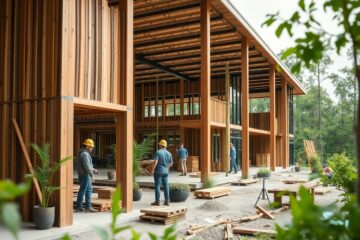Delve into the intricate web of real estate development and its profound impact on the environment. As urban landscapes continue to evolve, it is crucial to understand the far-reaching consequences of construction projects on our planet. From deforestation and habitat destruction to resource depletion and pollution, the environmental footprint of real estate development is undeniable.
Table of Contents
The Dynamics of Real Estate Development
Historical Context and Growth Patterns
Before diving into the current dynamics of real estate development, it is crucial to understand its historical context and growth patterns. Real estate development dates back centuries, with early civilizations engaging in land development to accommodate growing populations. Over time, urbanization and industrialization led to the rise of more structured approaches to development, giving birth to the real estate industry as we know it today.
The growth patterns of real estate development have been strongly influenced by economic shifts, technological advancements, and social trends. From the sprawling suburban neighborhoods of the post-World War II era to the contemporary mixed-use developments that promote sustainability, the evolution of real estate reflects the changing needs and values of society.
Key Players in Real Estate Development
Dynamics The key players in real estate development include developers, investors, architects, contractors, and government agencies. Developers spearhead projects, taking the financial risks and making crucial decisions to bring a vision to life. Investors provide the capital needed to fund developments, while architects and contractors collaborate to design and construct the physical structures. Government agencies regulate the industry and ensure compliance with zoning laws and building codes.
Growth Successful real estate development relies on effective collaboration among these key players, each bringing their expertise to the table. Developers must balance financial considerations with environmental and social impacts, while investors seek profitable returns on their investments. Architects and contractors are responsible for translating ideas into tangible assets, with government agencies serving as overseers to maintain standards and protect public interests.
Environmental Impact Assessment in Real Estate
Some of the most critical aspects of real estate development involve the environmental impact it may have on the surrounding area. In order to assess and mitigate these potential effects, Environmental Impact Assessments (EIAs) are crucial tools used in the planning and decision-making processes. By conducting thorough EIAs, real estate developers can better understand the implications of their projects and work towards sustainable solutions.
Understanding Environmental Impact Assessments (EIAs)
Impact assessments are comprehensive studies that evaluate the potential environmental consequences of a proposed development project. They consider factors such as air quality, water resources, wildlife, vegetation, noise levels, and overall ecosystem health. These assessments are conducted to identify, predict, and evaluate the potential impacts of a project, as well as to propose measures to mitigate any adverse effects on the environment. This process helps ensure that real estate developments are carried out responsibly and with consideration for the surrounding environment.
The Role of EIAs in Planning and Development
Assessment of the environmental impacts of real estate projects is essential in the planning and development stages. By incorporating EIAs into the decision-making process, developers can assess the potential risks and benefits of their projects, and make informed choices that promote sustainability and environmental conservation. These assessments also provide valuable insights to regulatory authorities, stakeholders, and the public, fostering transparency and accountability in real estate development.
Environmental Impact Assessments play a key role in guiding real estate projects towards environmentally responsible practices. They help mitigate potential harm to ecosystems, wildlife habitats, and local communities, while also identifying opportunities for enhancing environmental quality and promoting sustainability. By integrating EIAs into the development process, developers can not only comply with regulations but also demonstrate their commitment to preserving the environment for future generations.
Direct Environmental Effects of Real Estate Development
Landscape Alteration and Habitat Loss
Habitat alteration is a significant consequence of real estate development. When land is cleared for construction, natural habitats such as forests, wetlands, and grasslands are destroyed, leading to habitat loss for various plant and animal species. This alteration of the landscape can disrupt ecosystems and threaten biodiversity. Species that depend on specific habitats for survival can be pushed to the brink of extinction as their homes are destroyed to make way for buildings, roads, and other infrastructure.
Real estate development often results in fragmentation of habitats, isolating populations and limiting their ability to migrate and find essential resources. This can lead to a decline in genetic diversity and increase the vulnerability of species to environmental changes and natural disasters. In addition to direct habitat loss, the process of construction can also introduce invasive species and disrupt natural processes that are essential for ecosystem health.
Pollution from Construction Activities
On construction sites, various pollutants are released into the environment, including sediment, chemicals, and fossil fuel emissions. These pollutants can contaminate soil, water sources, and the air, leading to adverse effects on both human health and ecosystems. Sediment runoff from construction sites can clog waterways, affecting aquatic life and water quality. Chemicals used in construction, such as paints, solvents, and adhesives, can leach into the soil and groundwater, posing a risk to both wildlife and humans.
This contamination can have far-reaching consequences, impacting not only the immediate construction site but also surrounding areas through runoff and leaching. Efforts to mitigate pollution from construction activities include implementing erosion control measures, proper waste disposal, and the use of environmentally friendly construction materials and practices. By taking proactive steps to reduce pollution, developers can help minimize the environmental impact of their projects and protect local ecosystems for future generations.
Indirect Environmental Consequences
Urban Sprawl and Its Cascading Effects
To truly understand the indirect environmental consequences of real estate development, we need to delve into the phenomenon of urban sprawl and its cascading effects. Urban sprawl refers to the unplanned, uncontrolled expansion of urban areas into the surrounding countryside. This leads to the fragmentation of natural habitats, loss of agricultural land, and increased strain on infrastructure and resources.
With the spread of urban sprawl, there is a domino effect on the environment. Deforestation, soil degradation, and loss of biodiversity are just some of the far-reaching consequences. The increased demand for housing and amenities results in the destruction of green spaces, which play a crucial role in maintaining ecological balance and mitigating climate change.
Increased Traffic and Associated Emissions
For every new real estate development project that springs up, there comes a surge in vehicular traffic and associated emissions. Increased traffic congestion not only leads to longer commute times and frustrated drivers but also contributes significantly to air pollution and greenhouse gas emissions. The use of personal vehicles escalates, putting a strain on already overburdened roadways and public transportation systems.
Urban areas are particularly vulnerable to the negative effects of increased traffic and emissions. Poor air quality can have serious health implications for residents, leading to respiratory issues and exacerbating conditions such as asthma and heart disease. It is imperative to address this issue through sustainable urban planning and the promotion of public transportation and alternative modes of commuting.
Sustainable Real Estate Development Practices
Despite the negative impact that traditional real estate development can have on the environment, there are sustainable practices that can be implemented to minimize this impact. Sustainable real estate development focuses on creating structures that are both environmentally friendly and resource-efficient.
Principles of Green Building and Design
Principles of green building and design include using renewable resources, reducing energy consumption, minimizing waste, and creating a healthy indoor environment. Building materials should be sourced locally to reduce transportation emissions, and designs should optimize natural light and ventilation to reduce the need for artificial lighting and air conditioning.
Implementing green building practices can result in lower operating costs, increased property value, and a healthier living or working environment. By incorporating features like solar panels, rainwater harvesting systems, and energy-efficient appliances, real estate developers can significantly reduce the carbon footprint of their buildings.
Case Studies on Eco-friendly Developments
Estate One: Green Office Building in Seattle
- Location: Seattle, Washington
- Features: LEED Platinum Certification, green roof, solar panels
- Impact: 40% reduction in energy consumption
Estate Two: Eco-friendly Residential Complex in Portland
- Location: Portland, Oregon
- Features: Passive design, energy-efficient HVAC systems, native landscaping
- Impact: 50% reduction in water usage
To conclude, sustainable real estate development practices play a crucial role in mitigating the environmental impact of construction projects. By implementing green building principles and studying successful case studies, developers can create eco-friendly buildings that benefit both the planet and the occupants. It is important to prioritize sustainability in real estate development to ensure a healthier and more sustainable future for all.
Legal Framework and Policy Implications
International and National Regulations for Environmental Protection
For any real estate development project, it is crucial to adhere to both international and national regulations for environmental protection. These regulations are put in place to safeguard the environment and ensure sustainable development practices are followed. International agreements such as the Paris Agreement outline commitments to reduce greenhouse gas emissions and combat climate change on a global scale. On a national level, governments implement laws and regulations to protect ecosystems, wildlife, and natural resources from the impacts of development.
One of the key aspects of international and national regulations is the requirement for developers to conduct Environmental Impact Assessments (EIAs) before initiating any project. EIAs help in identifying potential environmental risks and developing mitigation measures to minimize negative impacts. By complying with these assessments, developers can ensure that their projects are in line with regulatory standards and contribute to preserving the environment for future generations.
The Importance of Compliance and Enforcement
One crucial aspect of sustainable real estate development is the importance of compliance and enforcement of environmental regulations. Without proper oversight and enforcement, developers may neglect environmental responsibilities, leading to irreversible damage to ecosystems and biodiversity. Compliance ensures that developers follow set guidelines and take necessary measures to protect the environment during and after construction.
One of the challenges in enforcement is ensuring that developers face consequences for non-compliance. Governments play a vital role in monitoring and enforcing environmental regulations, imposing fines or penalties on violators. By holding developers accountable for their actions, authorities promote a culture of responsibility and stewardship towards the environment.
International collaborations and information-sharing mechanisms are vital for effective enforcement of environmental regulations. By working together across borders, countries can address transboundary environmental issues and hold developers accountable for their impacts on a global scale. Additionally, sharing best practices and enforcement strategies can help raise awareness and build capacity for sustainable real estate development worldwide.
Challenges and Opportunities for the Future
Balancing Development and Environmental Conservation
Future real estate development must prioritize balancing the need for urban expansion with environmental conservation efforts. It is crucial to find a harmonious coexistence where economic growth can occur sustainably without further harm to our planet. This requires careful planning, innovative solutions, and a commitment to preserving our natural resources.
One way to achieve this balance is through sustainable design practices that integrate green spaces, energy-efficient technologies, and waste reduction strategies into new development projects. By considering the environmental impact of each decision made in the planning and construction phases, developers can contribute to a healthier planet for future generations to enjoy.
Innovations and Technological Advancements in Sustainable Real Estate
Environmental innovations and technological advancements are driving the future of sustainable real estate. From green building materials to smart energy systems, the industry is constantly evolving to reduce its carbon footprint and minimize environmental degradation. These advancements offer opportunities for developers to create more eco-friendly buildings and communities.
Technological solutions such as digital twin technology, renewable energy sources like solar power, and water recycling systems are revolutionizing the way real estate projects are designed and operated. These innovations not only reduce the environmental impact of development but also improve the quality of life for occupants and contribute to a more sustainable future for all.
Final Words
The impact of real estate development on the environment is a critical issue that requires careful consideration and proactive measures to minimize negative consequences. By recognizing the potential environmental impacts of real estate development, we can take steps to incorporate sustainable practices, such as green building designs, energy-efficient technologies, and responsible land use planning, to help mitigate these effects. It is crucial for developers, policymakers, and stakeholders to work together to find solutions that balance the need for development with the preservation of our natural resources.
The choices we make today in real estate development have long-lasting implications for the environment and future generations. As we continue to confront challenges such as urbanization, population growth, and climate change, it is essential to prioritize sustainable development practices that promote environmental conservation and resource efficiency. By taking a closer look at the impact of real estate development on the environment, we can strive to create a more sustainable built environment that benefits both people and the planet.
FAQ
Q: What is the impact of real estate development on the environment?
A: Real estate development can have various impacts on the environment, including habitat destruction, air and water pollution, increased energy consumption, and loss of biodiversity.
Q: How does habitat destruction occur due to real estate development?
A: Habitat destruction occurs when natural landscapes such as forests, wetlands, or grasslands are cleared to make way for buildings, roads, and other infrastructure. This can lead to the displacement and loss of wildlife species.
Q: What are some common sources of pollution from real estate development?
A: Common sources of pollution from real estate development include construction activities that generate dust and debris, as well as runoff from building sites that can carry sediment, chemicals, and other pollutants into nearby water bodies.
Q: How does real estate development contribute to increased energy consumption?
A: Real estate development often involves the construction of energy-intensive buildings that require heating, cooling, and lighting. Additionally, the urbanization and sprawl associated with real estate development can increase the demand for transportation, further contributing to energy consumption.
Q: What can be done to mitigate the negative impact of real estate development on the environment?
A: To mitigate the negative impact of real estate development on the environment, sustainable practices such as green building design, energy-efficient technologies, and green infrastructure can be implemented. Additionally, preserving green spaces, using sustainable materials, and promoting smart growth principles can help minimize environmental impacts.

Our contributing author is a passionate advocate for eco-friendly living and sustainability. With a background in eco-life, they are dedicated to inspiring and empowering individuals to adopt environmentally conscious lifestyles. Through insightful articles, they share practical tips, innovative solutions, and thought-provoking perspectives to promote a greener, more sustainable world. Join them on the journey towards eco-smart living and discover how small choices can make a big impact. 🌱









